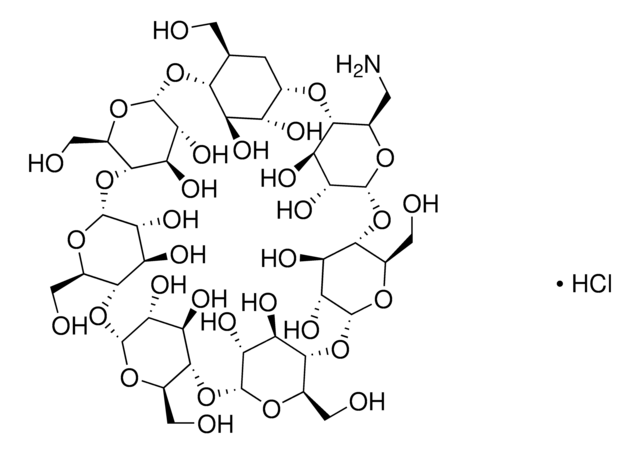The molecular weight for the β-Cyclodextrin moiety is 1135 g/mole and the contribution from the succinic acid portion is 100.1 g/mole. This mass is used for succinic acid as water is lost during the condensation reaction when cyclodextrin and succinic acid form the conjugate. Thus, the average molecular formula and average formula weight can be expressed as the following. C42H70-nO35 • (C4H5O3)n or 1135.0 + n •100.1 The average degree of substitution for this product is ~3.5 for this product making the molecular weight approximately ~1485 g/mole for this product. The degree of substitution can vary from 2.5 - 5 for this product and the batch specific certificate of analysis should be reviewed to gather the degree of substitution (n).
85990
Succinyl-β-cyclodextrin
Sinonimo/i:
succ-β-CD, succinyl-β-CD
About This Item
Prodotti consigliati
Stato
powder
Impurezze
~5% water
Colore
white
Punto di fusione
225 °C ((437 °F ) - Decomposes on heating)
Temperatura di conservazione
−20°C
Stringa SMILE
CC(=O)CCC(=O)OC[C@H]1O[C@@H]2O[C@H]3[C@@H](O)[C@H](O)[C@H](O[C@@H]3COC(=O)CCC(O)=O)O[C@H]4[C@@H](O)[C@H](O)[C@H](O[C@@H]4COC(=O)CCC(O)=O)O[C@H]5[C@@H](O)[C@H](O)[C@H](O[C@@H]5COC(=O)CCC(O)=O)O[C@H]6[C@@H](O)[C@H](O)[C@H](O[C@@H]6COC(=O)CCC(O)=O)O[C@H]7[C@@H](O)[C@H](O)[C@H](O[C@@H]7COC(=O)CCC(O)=O)O[C@H]8[C@@H](O)[C@H](O)[C@H](O[C@@H]8COC(=O)CCC(O)=O)O[C@H]1[C@@H](O)[C@@H]2O
InChI
1S/C71H100O55/c1-23(72)2-9-37(85)106-16-24-58-44(92)51(99)65(113-24)121-59-25(17-107-38(86)10-3-31(73)74)115-67(53(101)46(59)94)123-61-27(19-109-40(88)12-5-33(77)78)117-69(55(103)48(61)96)125-63-29(21-111-42(90)14-7-35(81)82)119-71(57(105)50(63)98)126-64-30(22-112-43(91)15-8-36(83)84)118-70(56(104)49(64)97)124-62-28(20-110-41(89)13-6-34(79)80)116-68(54(102)47(62)95)122-60-26(18-108-39(87)11-4-32(75)76)114-66(120-58)52(100)45(60)93/h24-30,44-71,92-105H,2-22H2,1H3,(H,73,74)(H,75,76)(H,77,78)(H,79,80)(H,81,82)(H,83,84)/t24-,25-,26-,27-,28-,29-,30-,44+,45+,46+,47+,48+,49+,50+,51+,52+,53+,54+,55+,56+,57+,58-,59-,60-,61-,62-,63-,64-,65-,66-,67-,68-,69-,70-,71-/m1/s1
DIRLEDPEXJLCIL-JCWBWLHSSA-N
Descrizione generale
Applicazioni
Succinyl-β-cyclodextrin and carboxymethyl-β-cyclodextrin are used as chiral selective agents in capillary electrophoresis for the separation of di- and tri-peptide enantiomers and catechin enantiomers. Succinyl-β-cyclodextrin is used to optimize analysis of PNA-DNA duplexes with diethylthiadicarbocyanine dye.
Altre note
Codice della classe di stoccaggio
11 - Combustible Solids
Classe di pericolosità dell'acqua (WGK)
WGK 3
Punto d’infiammabilità (°F)
Not applicable
Punto d’infiammabilità (°C)
Not applicable
Dispositivi di protezione individuale
Eyeshields, Gloves, type N95 (US)
Scegli una delle versioni più recenti:
Possiedi già questo prodotto?
I documenti relativi ai prodotti acquistati recentemente sono disponibili nell’Archivio dei documenti.
-
What is the molecular weight of this product?
1 answer-
Helpful?
-
Active Filters
Il team dei nostri ricercatori vanta grande esperienza in tutte le aree della ricerca quali Life Science, scienza dei materiali, sintesi chimica, cromatografia, discipline analitiche, ecc..
Contatta l'Assistenza Tecnica.








